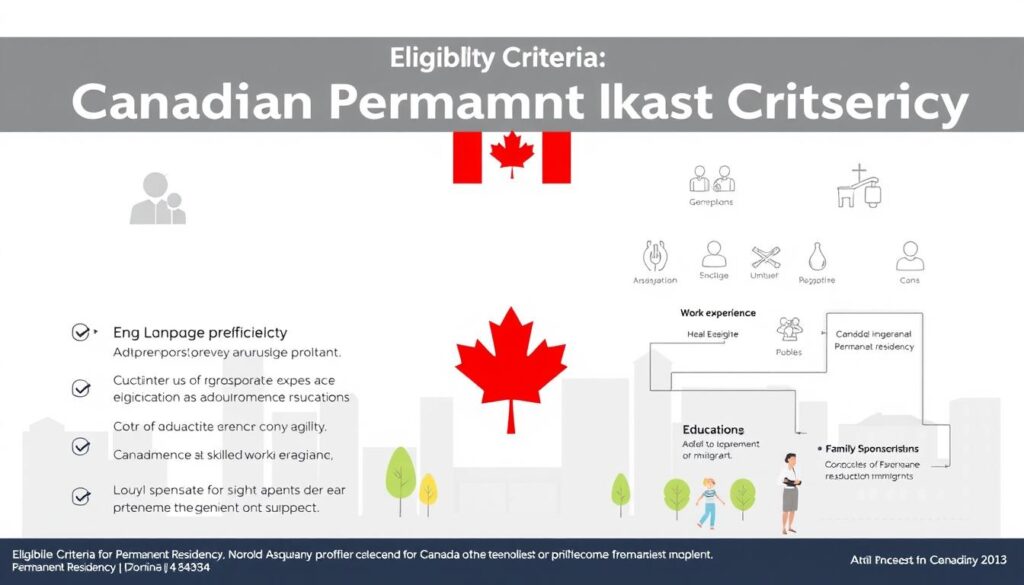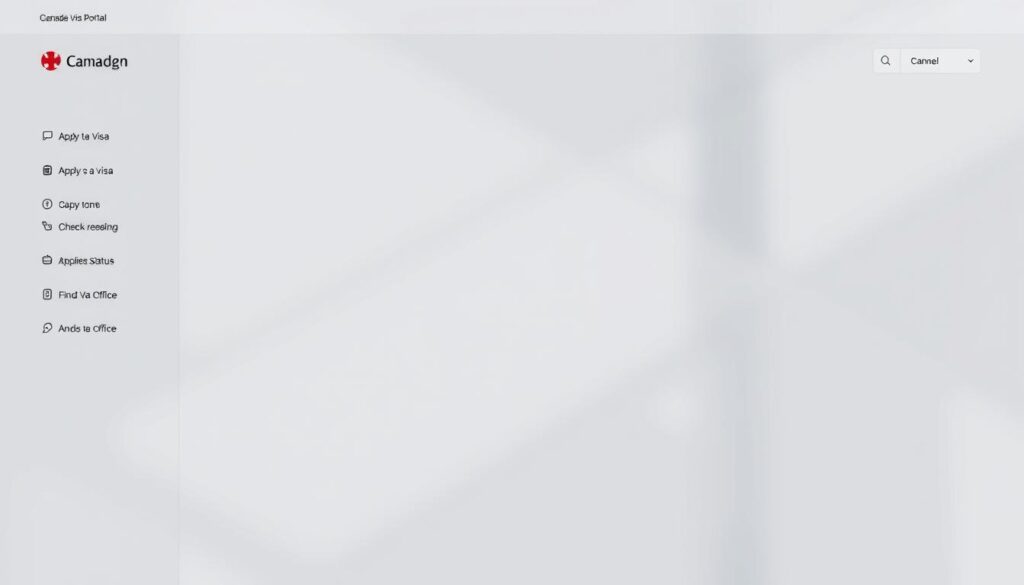Over 400,000 individuals become permanent residents in Canada each year. The process is now simpler than ever, thanks to the Canada Visa Portal. This official platform streamlines submissions, ensuring a smooth journey toward long-term residency.
Gaining permanent residency unlocks key benefits, including access to healthcare and pathways to citizenship. The portal allows secure document uploads and real-time tracking, eliminating delays.
Ready to begin? Follow the step-by-step guidance tailored for applicants using verified channels. Your future in Canada starts here.
What Is Permanent Residency (PR) in Canada?
Canada’s permanent residency program provides a gateway to essential rights and benefits. Permanent residency status allows you to live, work, or study anywhere in Canada indefinitely. Unlike temporary visas, it’s a long-term solution with a clear path to citizenship Canada.

Benefits of Canadian PR
As a permanent resident, you gain access to:
- Universal healthcare coverage under provincial plans
- Public education for children at no cost
- Freedom to work for any employer nationwide
- Social security benefits like pensions and unemployment insurance
- Ability to sponsor relatives for family reunification
Difference Between PR and Citizenship
While both grant residency, key distinctions exist. Permanent residents cannot vote or hold public office. Citizenship, however, requires living in Canada for at least 1,095 days (3 years) within 5 years of applying.
Another difference involves travel. Citizens use a Canadian passport, while permanent residency holders must maintain their status by residing in Canada for 730 days every 5 years.
Eligibility Criteria for Canadian Permanent Residency
Meeting the eligibility criteria is the first step toward securing permanent residency in Canada. The federal government evaluates applicants based on language skills, education, professional background, and financial stability. Each factor contributes to your Comprehensive Ranking System (CRS) score, determining your chances of approval.

Language Proficiency Requirements
Canada requires proof of language ability in English or French. You must achieve a minimum of CLB 7 in approved tests:
- IELTS or CELPIP for English
- TEF Canada or TCF Canada for French
Scores are valid for two years. Higher results boost your CRS points.
Educational and Work Experience Criteria
Your academic and professional background must align with Canada’s needs:
- An Educational Credential Assessment (ECA) verifies foreign degrees.
- At least one year of skilled work experience in NOC 0, A, or B occupations.
“Skilled work includes managerial, technical, or trade roles critical to Canada’s economy.”
Financial Proof Requirements
You must demonstrate sufficient funds to settle in Canada. For 2023, the minimum required is:
- $13,757 for a single applicant
- Additional amounts for family members
Exemptions apply if you have a valid job offer. Medical exams and police clearance certificates are also mandatory.
How to Apply for PR in Canada: Step-by-Step Process
The journey toward long-term residency begins with understanding key steps. Each phase ensures your submission meets IRCC standards, minimizing delays. Below, we break down the application process for clarity.
Step 1: Confirm Your Eligibility
Start by using the IRCC online tool. It evaluates your age, education, and work experience against programs like Express Entry. If eligible, you’ll receive a personalized checklist.
Step 2: Select the Best Immigration Pathway
Compare four main options:
- Express Entry: For skilled workers with CRS scores.
- Provincial Nominee Program (PNP): Tied to regional labor needs.
- Canadian Experience Class (CEC): For temporary residents with local work experience.
- Family Sponsorship: Requires a relative’s support.
Step 3: Prepare Your Documents
Essential documents include:
- ECA reports for foreign education.
- Language test results (IELTS/CELPIP or TEF).
- Employment reference letters.
“Missing documents are the top cause of rejection. Verify every item against IRCC’s checklist.”
Step 4: Submit Through the Canada Visa Portal
Upload files directly to the portal. Double-check formats—PDFs under 4MB work best. Track progress via your secure account.
Step 5: Pay the Required Fees
The total fees for a principal applicant are $1,365 CAD. This includes processing ($850) and right-of-permanent-residence fees ($515).
Step 6: Await Processing
Standard timelines range from 6–8 months. Delays may occur if additional checks are needed. Avoid status inquiries unless exceeding posted wait times.
Popular Immigration Programs for PR in Canada
Canada offers multiple pathways to secure permanent residency, each tailored to different qualifications. Whether you’re a skilled worker, have family in Canada, or already contribute locally, a program fits your profile.

Express Entry System
The Express Entry system ranks candidates using the Comprehensive Ranking System (CRS). Points are awarded for age, education, language skills, and work experience.
Top-scoring applicants receive an Invitation to Apply (ITA). Recent draws required CRS scores between 480–500. Processing typically takes 6 months.
Provincial Nominee Program (PNP)
Provinces nominate candidates addressing local labor gaps. Ontario prioritizes tech workers, while British Columbia targets healthcare and trades.
A provincial nomination adds 600 CRS points, nearly guaranteeing an ITA. Processing varies from 6–18 months.
Family Sponsorship
Canadian citizens or permanent residents can sponsor relatives. Spousal sponsors must prove income meeting LICO thresholds.
Processing averages 12 months. Sponsors commit to financial support for up to 20 years.
Canadian Experience Class (CEC)
This program requires 1 year of skilled work in Canada. Temporary residents with NOC 0, A, or B roles qualify.
CEC applications process faster, often within 4–6 months. No proof of funds is needed if already employed locally.
| Program | Processing Time | Key Requirement |
|---|---|---|
| Express Entry | 6 months | CRS score ≥ 480 |
| PNP | 6–18 months | Provincial nomination |
| Family Sponsorship | 12 months | Sponsor meets LICO |
| CEC | 4–6 months | 1 year Canadian work |
Choosing the right program accelerates your journey. Review eligibility and timelines to align with your goals.
Navigating the Canada Visa Portal
Efficiently manage your residency application through the official online portal. This platform ensures secure submissions and instant updates, reducing administrative delays.

Creating an Account
Start by registering with a GCKey. Enable two-factor authentication for added security. The system guides you through profile setup, including contact details and password creation.
Filling Out the Application Form
The digital form covers:
- Personal history (addresses, employment)
- Travel records for the past decade
- Family information for dependents
Use the auto-save feature to avoid data loss. Partial submissions can be retrieved within 60 days.
Uploading Required Documents
Ensure files meet these standards:
- PDF format under 4MB
- High-resolution scans (300 DPI minimum)
- Certified translations for non-English/French materials
“Incomplete uploads delay processing. Verify each document against the checklist before submission.”
Track progress via the portal dashboard, which displays real-time status updates. Notifications alert you to missing items or approvals.
Common Mistakes to Avoid When Applying for PR
Many applicants face avoidable setbacks during their residency journey. Small oversights—like unsigned forms or outdated documents—can trigger rejections. Understanding these pitfalls ensures your application stays on track.

Incomplete or Incorrect Applications
Submissions missing signatures or expired paperwork are instantly flagged. Verify all fields match your passport exactly. Even minor discrepancies in names or dates risk delays.
Common errors include:
- Uncertified translations for non-English/French documents
- Missing Employment Reference Letters with job duties
- Address history gaps exceeding 30 days
“Misrepresentation—even unintentional—can result in a 5-year ban from reapplying.”
Missing Deadlines
IRCC allows 60 days to respond to requests. Late replies may close your file. Set reminders for:
- Medical exam expiry dates (valid for 12 months)
- Police certificates (typically 6-month validity)
- Biometrics requests (30-day window)
Neglecting Language Test Preparation
Achieving CLB 7 or higher is critical for eligibility. Low scores reduce CRS points. Use official IELTS/CELPIP practice materials to target:
- 6.0 in IELTS Writing
- 7.0 in Listening for CELPIP
Avoid unregistered consultants promising guaranteed approvals. Only licensed professionals can legally advise on immigration matters.
By sidestepping these errors, you streamline the process. Double-check every detail against IRCC’s requirements before submitting.
Tips for a Successful PR Application
A smooth application journey requires attention to detail. Proper preparation minimizes errors and speeds up processing. Follow these strategies to enhance your chances of approval.
Double-Check Your Documents
Errors in paperwork cause most delays. Implement a three-step verification system:
- Compare each document against the IRCC checklist
- Ensure signatures and dates are current
- Verify translations are certified for non-official languages
Pay special attention to employment records. Reference letters must detail job duties, salary, and duration.
Seek Professional Advice if Needed
Licensed consultants provide valuable guidance. Look for CICC-registered professionals in major cities:
- Toronto: 42 active consultants
- Vancouver: 28 certified experts
- Montreal: 19 bilingual advisors
“ICCRC-certified consultants understand evolving immigration policies better than unregulated services.”
Stay Updated on Policy Changes
Rules evolve frequently. Subscribe to IRCC newsletters for real-time updates. Recent changes affect processing times and eligibility criteria.
Build timeline buffers for police clearances. Some countries take weeks to issue PCCs. Starting early prevents last-minute rushes.
Following these steps ensures your process remains efficient. Stay organized, seek help when necessary, and monitor updates regularly.
What to Do After Receiving Your PR Status
Securing permanent residence status is just the beginning of your Canadian journey. The next steps involve activating your Confirmation of Permanent Residence (COPR) and understanding long-term obligations. Proper planning ensures you maintain your status while enjoying all associated rights.
Activating Your Permanent Residence
Upon arrival, present your COPR to border officials. They’ll verify your documents and officially grant residency. Complete these steps within your first weeks:
- Apply for your PR card (processing takes ~90 days)
- Obtain a Social Insurance Number (SIN) at Service Canada
- Register for provincial healthcare coverage
“PR cards typically arrive by mail within 6-8 weeks. Temporary residents can use their COPR for identification until receipt.”
Maintaining Your Residency Status
Canada requires permanent residence holders to live in the country for at least 730 days every five years. Exceptions apply for:
- Accompanying a Canadian citizen spouse abroad
- Working for Canadian businesses overseas
- Government-posted employees
Track your travel dates carefully. Border officers may request proof of compliance during re-entry.
Essential Post-Arrival Responsibilities
New residents must file Canadian taxes on worldwide income. Even if you earn money abroad, declare it to the CRA. Key documents to gather:
- T4 slips from Canadian employers
- Foreign income statements (converted to CAD)
- Receipts for eligible deductions
When traveling, always carry your PR card or Permanent Resident Travel Document (PRTD). The latter is required if returning by commercial vehicle without a valid PR card.
Frequently Asked Questions About PR in Canada
Understanding common queries helps streamline your residency journey. Below, we clarify timelines, family inclusion, and critical policies.
Processing Timelines by Program
Wait times vary based on the application pathway. Recent 2023 averages:
| Program | Processing Time |
|---|---|
| Express Entry | 6 months |
| Provincial Nominee Program (PNP) | 6–18 months |
| Family Sponsorship | 12 months |
Delays may occur if additional verifications are needed. Track progress via your Canada Visa Portal account.
Including Family Members
Your permanent residency submission can cover:
- Spouses or common-law partners
- Children under 22 years (exceptions for full-time students)
“Dependents must pass medical exams. Pre-existing conditions rarely cause refusal unless posing public health risks.”
Medical Exam Validity
Results expire after 12 months. If your process exceeds this period, IRCC may request re-testing. Book exams with panel physicians early to avoid lapses.
RPRF Refund Policies
The Right of Permanent Residence Fee ($515) is refundable if you withdraw before processing begins. After approval, only visa refusal triggers reimbursement.
Dual Intent for Visitor Visa Applicants
You may pursue residency while holding a temporary visa. Officers assess genuine intent to leave if the application is denied. Maintain proof of ties to your home country.
Conclusion
Securing long-term residency becomes seamless with the Canada Visa Portal. Its digital tools simplify tracking and document uploads, reducing delays in your permanent residency journey.
Start gathering paperwork early—language tests and police certificates expire. Rising CRS scores in Express Entry make provincial nominations a smart backup for competitive profiles.
Before submission, verify PDF sizes and translations. The right preparation ensures a smooth process. Your future in Canada starts with a well-managed application.



